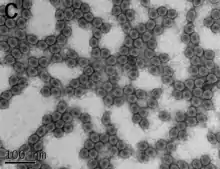Bromovirus
Bromovirus is a genus of viruses, in the family Bromoviridae.[3] Plants serve as natural hosts. There are currently six species in this genus including the type species Brome mosaic virus.[2][4]
| Bromovirus | |
|---|---|
 | |
| Transmission electron micrograph of brome mosaic virus (BMV) virions | |
 | |
| Crystal structure of Brome mosaic virus, PDB entry 1js9[1] | |
| Virus classification | |
| (unranked): | Virus |
| Realm: | Riboviria |
| Kingdom: | Orthornavirae |
| Phylum: | Kitrinoviricota |
| Class: | Alsuviricetes |
| Order: | Martellivirales |
| Family: | Bromoviridae |
| Genus: | Bromovirus |
| Type species | |
| Brome mosaic virus | |
| Species[2] | |
| |
Taxonomy
Group: ssRNA(+) Order: Martellivirales
- Family: Bromoviridae
- Genus: Bromovirus
- Broad bean mottle virus
- Brome mosaic virus
- Cassia yellow blotch virus
- Cowpea chlorotic mottle virus
- Melandrium yellow fleck virus
- Spring beauty latent virus
- Genus: Bromovirus
- Family: Bromoviridae
Structure
Viruses in the genus Bromovirus are non-enveloped, with icosahedral geometries, and T=3 symmetry. The diameter is around 26 nm. Genomes are linear and segmented, tripartite.[2][4]
| Genus | Structure | Symmetry | Capsid | Genomic arrangement | Genomic segmentation |
|---|---|---|---|---|---|
| Bromovirus | Icosahedral | T=3 | Non-enveloped | Linear | Segmented |
Life cycle
Viral replication is cytoplasmic. Entry into the host cell is achieved by penetration into the host cell. Replication follows the positive stranded RNA virus replication model. Positive stranded rna virus transcription, using the internal initiation model of subgenomic RNA transcription is the method of transcription. The virus exits the host cell by tubule-guided viral movement. Plants serve as the natural host. Transmission routes are mechanical and contact.[2][4]
| Genus | Host details | Tissue tropism | Entry details | Release details | Replication site | Assembly site | Transmission |
|---|---|---|---|---|---|---|---|
| Bromovirus | Plants | None | Viral movement; mechanical inoculation | Viral movement | Cytoplasm | Cytoplasm | Mechanical inoculation: insects; contact |
Recombination
Brome mosaic virus (BMV) genomes are able to undergo RNA-RNA homologous recombination upon infection of plant cells.[5] The RNA-dependent RNA polymerase specified by the BMV genome appears to undergo template switching (copy choice) recombination during viral RNA synthesis.[6]
References
- Lucas, R. W.; Larson, S. B.; McPherson, A. (2002). "The crystallographic structure of Brome mosaic virus". Journal of Molecular Biology. 317 (1): 95–108. doi:10.1006/jmbi.2001.5389. PMID 11916381.
- "ICTV Report Bromoviridae".
- Bujarski, J; Gallitelli, D; García-Arenal, F; Pallás, V; Palukaitis, P; Reddy, MK; Wang, A; ICTV Report, Consortium (August 2019). "ICTV Virus Taxonomy Profile: Bromoviridae". The Journal of General Virology. 100 (8): 1206–1207. doi:10.1099/jgv.0.001282. PMID 31192783.
- "Viral Zone". ExPASy. Retrieved 15 June 2015.
- Lai MM. RNA recombination in animal and plant viruses. Microbiol Rev. 1992 Mar;56(1):61-79. PMID: 1579113; PMCID: PMC372854
- Kim MJ, Kao C. Factors regulating template switch in vitro by viral RNA-dependent RNA polymerases: implications for RNA-RNA recombination. Proc Natl Acad Sci U S A. 2001 Apr 24;98(9):4972-7. doi: 10.1073/pnas.081077198. Epub 2001 Apr 17. PMID: 11309487; PMCID: PMC33148